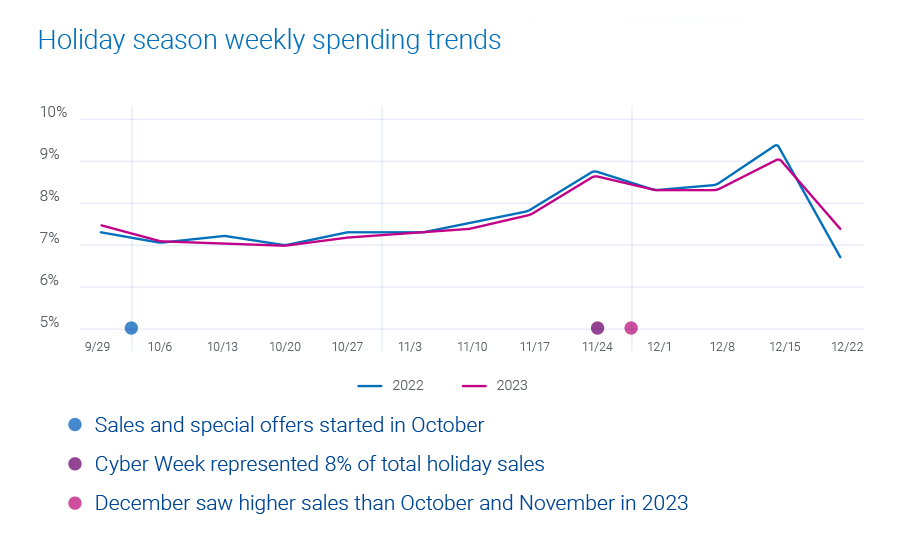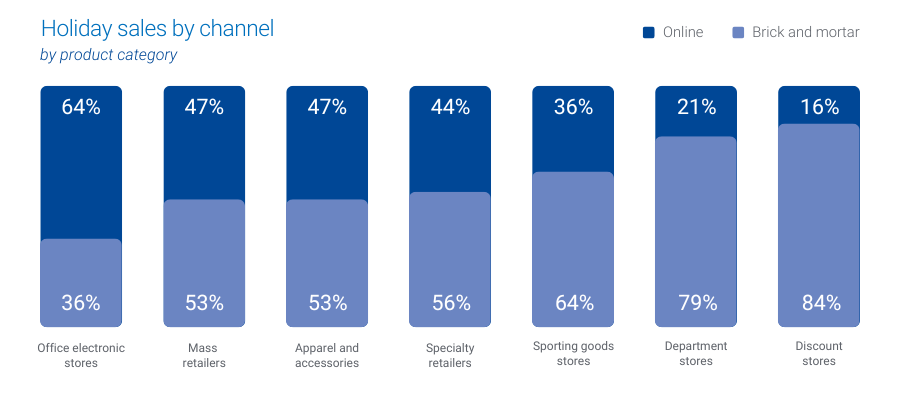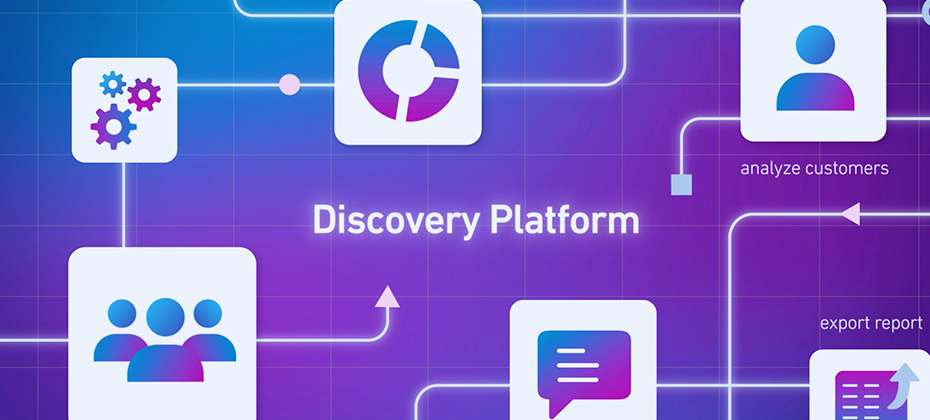
This holiday shopping season, marketers will look to take advantage of the surge in spending across channels like connected TV (CTV), programmatic, and mobile. Despite challenges such as privacy regulations and Google’s new cookie deprecation plan, this moment presents a unique opportunity for marketers to reshape their traditional approaches to consumer engagement and capitalize on these changes.
As we approach the holiday season, understanding how consumers spend, where they shop, and how their shopping habits are changing are key components to consider when crafting your holiday advertising campaigns. Our 2024 Holiday spending trends and insights report utilizes our expertise in data and insights to highlight emerging consumer behaviors and spending patterns. In our report, we share what these trends mean for marketers and how Experian can help, so you can refine your messaging and target the right audience through the best channels.
In this blog post, we cover three insights from our report. Watch our video for a recap below.
1. Consumers are shopping evenly throughout the holiday season
35% of holiday shopping was done in December, peaking at 9% of total holiday sales the week before Christmas. Cyber Week, the five-day period between Thanksgiving and Cyber Monday, and the week before Christmas brought the highest weekly sales for the past two holiday seasons.

What this means for marketers
Prepare for an extended promotional period. Schedule your marketing campaigns and sales initiatives to maximize impact during the extended season, focusing on the peaks of Cyber Week and the week before Christmas.
How Experian can help you target these shoppers
Experian’s data, ranked #1 in accuracy by Truthset, offers advertisers the ability to reach people based on demographic, geographic, and behavioral attributes (e.g. websites visited and purchase history). Our audiences are available on-the-shelf of most major platforms, making it easy for you to activate and target holiday shoppers.
We recently released 19 new holiday-focused audience segments. Here are a few you can activate:
- Black Friday Shoppers
- Cyber Monday Shoppers
- Big Box/Club Store Shoppers
- Luxury Gift Shoppers
- Discount Holiday Shoppers
- Holiday Airline Travel
2. Online shopping is leveling out
Online holiday spending continues to remain around a third of all holiday shopping spending.
We are starting to see online shopping slow and level out – people are going back in-store. The high amount of online shopping we saw during the pandemic is starting to return to pre-pandemic behaviors.

Consumers are spending more in-store at department and discount stores but are shopping online for office/electronics/games, mass retailers, and apparel.

- 84% of holiday shopping was done in-store for discount stores.
- 79% of holiday shopping was done in-store for department stores.
- 64% of holiday shopping was done online for office, electronics, and games stores.
What this means for marketers
Digital and physical experiences work together. Retailers should have a multi-channel plan to reach consumers, tailoring their approach to their target audience and product and creating engaging in-store experiences to drive visitors.
How Experian can help you target and measure across channels
We connect online and offline data to enable precise targeting and measurement of marketing efforts across multiple channels. Read our case study with Cuebiq to learn how they used our Activity Feed solution to deliver in-store lift analyses to their clients.
3. CTV is the top channel to reach consumers
Over two-thirds of the U.S. population now use CTV, and the average time spent among adults is expected to surpass two hours per day in 2024. CTV offers a creative ad experience similar to its linear counterpart but provides more sophisticated targeting and analytics capabilities.
What this means for marketers
As CTV viewing continues to dominate, the importance of cross-device targeting and measurement increases.
How Experian can help you reach shoppers across devices
Later this year, we’ll add support for IPv6 in our Digital Graph as well as phone-based UID2s. This is in addition to our current coverage of IPv4 and email-based UID2s. As a result, all IP signals and UID2s will be resolved back to Experian’s household and individual profiles and their associated devices, which means marketers and platforms can better understand the full customer journey and reach people across their devices.
Download our 2024 Holiday spending trends and insights report
This holiday season is about more than just transactions – it’s about cultivating meaningful connections with your audience. Download our 2024 Holiday spending trends and insights report to access all of our predictions for this year’s holiday season.
When you work with Experian for your holiday shopping campaigns, you’re getting:
- Accurate consumer insights: Better understand your customers’ behavioral and demographic attributes with our #1 ranked data covering the full U.S. population.
- Signal-agnostic identity solutions: Our deep understanding of people in the offline and digital worlds provides you a persistent linkage of personally identifiable information (PII) data and digital IDs, ensuring you accurate cross-device targeting, addressability and measurement.
- Secure connectivity: Bring data and identity to life in a way that meets your needs by securely sharing data between partners, utilizing the integrations we have across the ecosystem, and using our marketing data in flexible ways.
Make the most of this holiday shopping season with Experian. Contact us today to get started.
Latest posts

Third-party cookies have been a crucial component in people-based advertising and digital identity. With Google's recent announcement of delaying third-party cookie deprecation to 2024, the industry has more time to rethink how to effectively identify and communicate with consumers when the time comes. Preparing for cookie deprecation Solving for the post-cookie world is mission critical, particularly as consumer expectation for a relevant digital experience is heightened. We’ve seen a number of industry participants, including brands, publishers, data providers and technology platforms, work around the clock to find an alternative to third-party cookies—one that amasses the same scale and reach but also maintains consumer privacy. In fact, industry insights echo that sentiment. According to a white paper from Winterberry Group, Collaborative Data Solutions: The Evolution of Identity in a Privacy-First, Post-Cookie World, sponsored in part by Experian, one of the most frequently heard comments was the urgency for the industry to develop post-cookie, privacy compliant solutions that work in a more integrated manner. And if there was one overarching position regarding the research into the future of identity, it’s that collaboration is key. Participants in the white paper expressed that with the elimination of third-party cookies, there will be a surge in collaborative solutions across and within companies to accommodate changes in the digital marketplace. Collaborative data solutions must move beyond new post-cookie identity replacements and encompass more holistic approaches, including first-party data. First-party data sharing Currently, 64.3 percent of organizations in the US collaborate with other organizations to share first-party data for insights, activation, measurement or attribution, and 16.7 percent in the U.S. have plans to. Virtually all US companies surveyed were aware of the option to collaborate with other organizations and expressed openness to discussions around sharing first-party data. What is the solution to third-party cookie deprecation? The deprecation of third-party cookies is creating a shock in the marketing and advertising world because there has been an over-dependence on one type of identifier. Therefore, the solution to identify consumers across the digital ecosystem will not come from a single replacement for third-party cookies. Instead, it will rely on a combination of solutions, including collaborative data between organizations and implementation of proprietary first-party data strategies, as well as a framework that can connect all these touchpoints together. Experian can help you navigate the cookieless future Experian is focused on building a more effective advertising ecosystem that promotes the interoperability of digital touchpoints while enabling and fostering new innovations in a privacy forward way. Contact us today and get started with building connected identity in the ever-changing data landscape. To learn more, watch the recording of our webinar with The Vitamin Shoppe where we discuss identity and how you can drive more addressable audience strategies amidst diminishing data signals.

As today’s digital landscape gets more and more complicated there are more ways for brands to connect with users and drive purchases and more ways for ad tech to target and measure those touch points. As in-person shopping picks up steam due to the re-normalization of society post-COVID 19; the connection between digital ads and in-person purchases needs to be made once again. With the rise of Connected TV throughout the pandemic there are even more digital opportunities to target a user. But how do you make sure that those brand engagements are captured and correctly attributed to offline purchases and conversions? The answer lies in a holistic identity resolution strategy. Cross-device identity resolution with The Tapad Graph connects the identifiers and devices of individuals within a household to each other; enabling targeting, frequency capping, extension, segmentation and measurement or attribution between devices; including Connected TV and hashed (privacy-protected) email addresses along with Cookies, Mobile Ad Ids and IP Address. Brands can join their first-party data to The Tapad Graph to execute strategies that connect online and offline data for pre, mid and post-campaign efficiencies. Let’s imagine a scenario in which an outdoor retail brand is targeting users watching specific content on a Connected TV device. Powered by identity resolution, they start with a general ad on CTV and continue targeting down individual paths with each user. When one of them converts in store and makes a purchase; the outdoor retailer can connect that action through location and in-store traffic data with the cross-device identity resolution used to execute the digital campaign. Now the actions of the user online and offline are resolved for more accurate measurement and attribution after the campaign ends. But it doesn’t stop there– the brand's CRM data can be reactivated for the next digital campaign and leveraged to capitalize on the most effective media mix for the user who made the purchase previously. These combined insights can be invaluable in shaping up future campaign strategies with geo-contextual ads, recommended additional products and personalization to help drive more conversions and purchases in-store or online. As in-person shopping picks back up and marketers are tasked once again with balancing online and in-store KPIs, the right identity resolution strategy can unlock necessary efficiencies for retailers, ad tech vendors and agencies tasked with supporting these initiatives. Get started with The Tapad Graph For personalized consultation on the value and benefits of The Tapad Graph for your business, email Sales@tapad.com today!

Imagine an experiential self-driving car of the future. You step inside, select where you want to go and the best experience within the vehicle for your journey. Within seconds, it safely sweeps you away and drives you to your destination. If only marketing were that easy. At the tap of a console, you are able to identify the best parachute to glide your ads to the right audience, on the right platform. Well, what seems like a distant dream is Experian Marketing Service’s latest solution: Discovery Platform. To introduce Discovery, we asked Sunaina Chaudhary, Director of Product and Innovation, to describe how the solution facilitates effective marketing strategies. Discover more about your consumers. What is Discovery? What marketing challenges does it address? Anywhere you feel like you need to understand your customers, Discovery Platform can help. Whether you want to take your marketing to the next level or get on the road to recovery, Discovery is the solution. We created the Discovery Platform to help our clients overcome today’s advertising challenges, including gaps in data that impede identity linkage, limited internal resources and fragmented data. Think about all the touchpoints surrounding a customer in real life: connected TV ads, social media, email, flyers, digital ads . . . You can probably think of at least 15 off the top of your head. Discovery brings all those touchpoints together into a unified view of your customer. It combines disparate data insights to help you better understand your customers’ individual journeys and the most impactful touchpoints across offline, social and digital channels. Speaking specifically to a use case, in the most simplistic words, marketers can use Discovery to identify the right consumer, plan to reach them through the most optimal channel and create a consistent, relevant and personalized message. You can even leverage Discovery Platform’s seamless integration with our Audience Engine solution to build and deploy custom audiences to a variety of social, digital, email and Connected TV partners. The sales and other customer data flowing back into Discovery, all ties together for the marketing team to inform the next marketing campaign or strategy. Watch the Discovery Platform demo to learn more. Which business verticals does it benefit? Discovery Platform is apt for almost every vertical that I can think of – retail, agency, connected TV, publishers and financial institutions. Even though agencies don’t typically own first-party data, they can still benefit from Discovery through a one-stop shop for their RFP needs and the ability to activate the same audience with a click of a button. Clear cohorts you can activate—without privacy anxiety. Do marketers need to worry about consumer data privacy in the Discovery platform? No, when you’re in Discovery, you’re seeing the best and safest view of your customer cohorts. Marketers can rely on Experian to meet all compliance, governance and privacy standards. That’s taken care of by the time you see the data. Discovery is built on carefully curated and maintained data on 126 million households and 300 million individuals. You can leverage it for insights on over 2,000 consumer attributes such as demographics, home-owner status, shopping behaviors, media consumption habits and more. These are all tied to a unified identity made possible by our identity linkage. To do this, we help pull together your first-party data—along with whatever Experian datasets you license—to create a complete picture of your customer cohorts. It’s always-on, actionable insights you can subscribe to. What most excites you about the Discovery platform? We live in a world full of subscriptions—from TV streaming to food delivery. Data solutions of the past are transactional: you buy consumer data, leave it, and need to update it next week, month or quarter. Marketers have an ongoing need for more up-to-date data. That’s why we built Discovery Platform. World-class marketers need to be proactive when it comes to their customers and their business, which means having access to always-on actionable insights and analytics. Experian’s Discovery platform is here to make recurring market insights safer to access, and easier to collect and put into action. Here are 3 ways you can put Discovery to work for your marketing strategy: Subscribe! You get data-backed insights when you need them to stay up to date on what's happening with your business, customers and campaigns. For example, through mobile location data you can see which geographic areas of your market are returning to stores or still shopping online, glimpse competitor market share and more. Connect insights to your campaign. Discovery Platform is seamlessly integrated with Audience Engine to turn insights into action. This allows you to engage with your audiences via email, social, display, connected TV or whatever channels they prefer. Request a report. Not ready to subscribe? You can still get valuable on-demand reports, whether you have one or 25 target markets. Tell us your audience selection criteria, pick datasets for rich insights and Experian Marketing Services will give you actionable marketing insights for your business. Sign up for our newsletter to receive quarterly updates on what’s new at Experian Marketing Services.